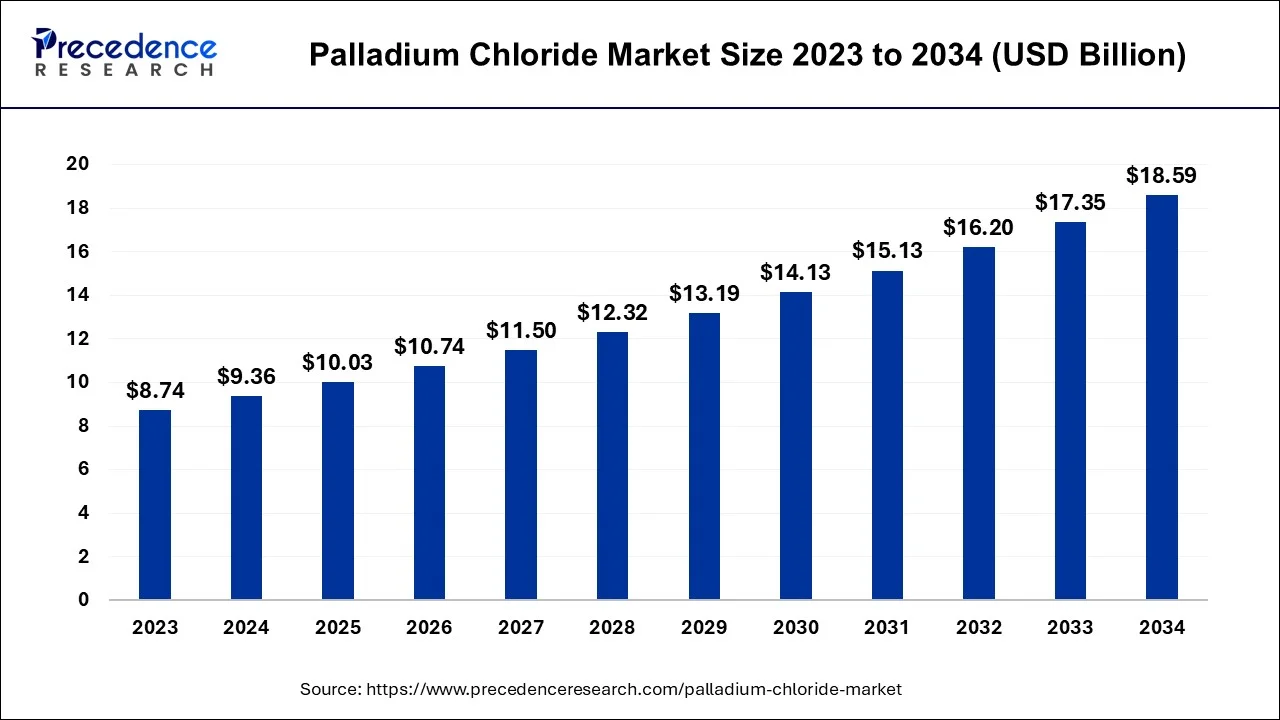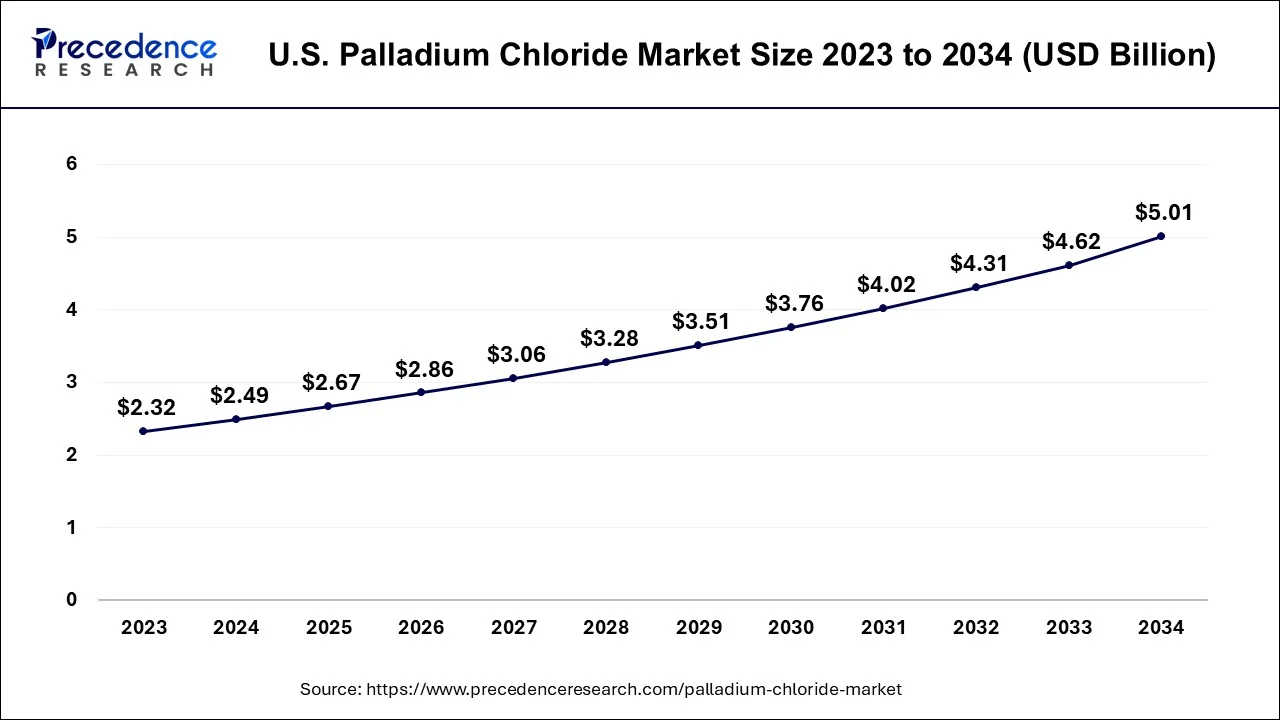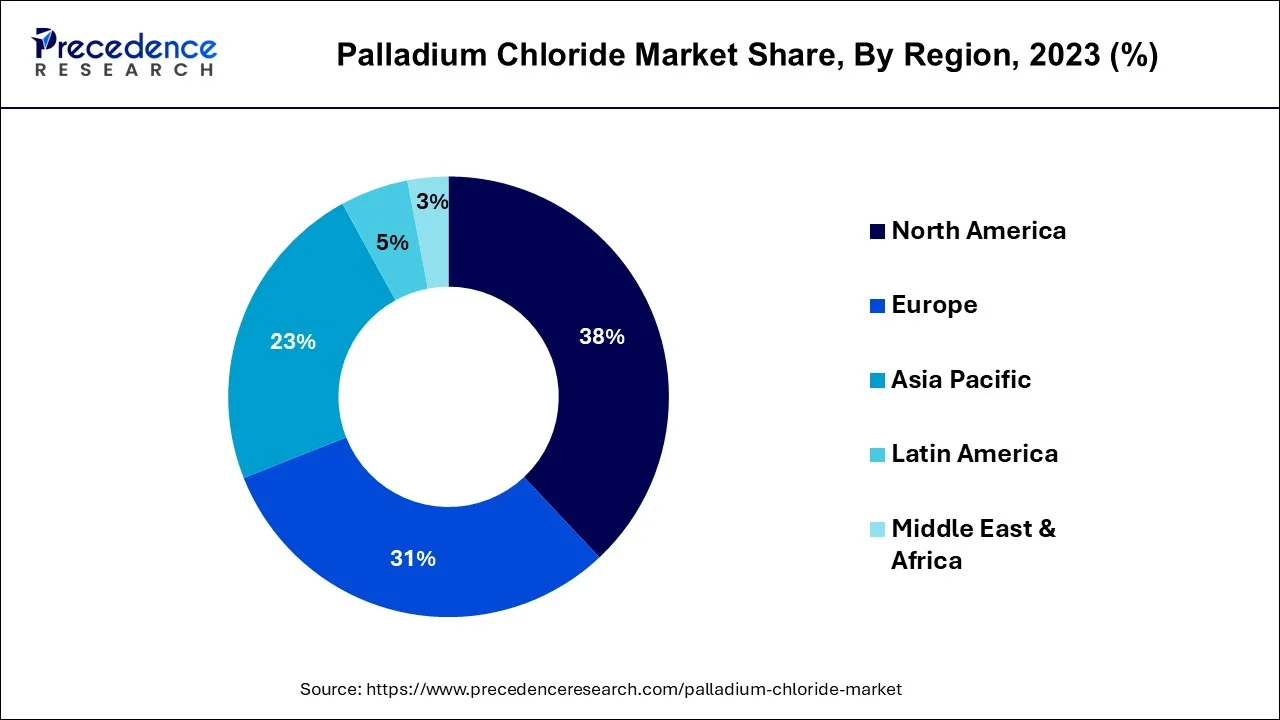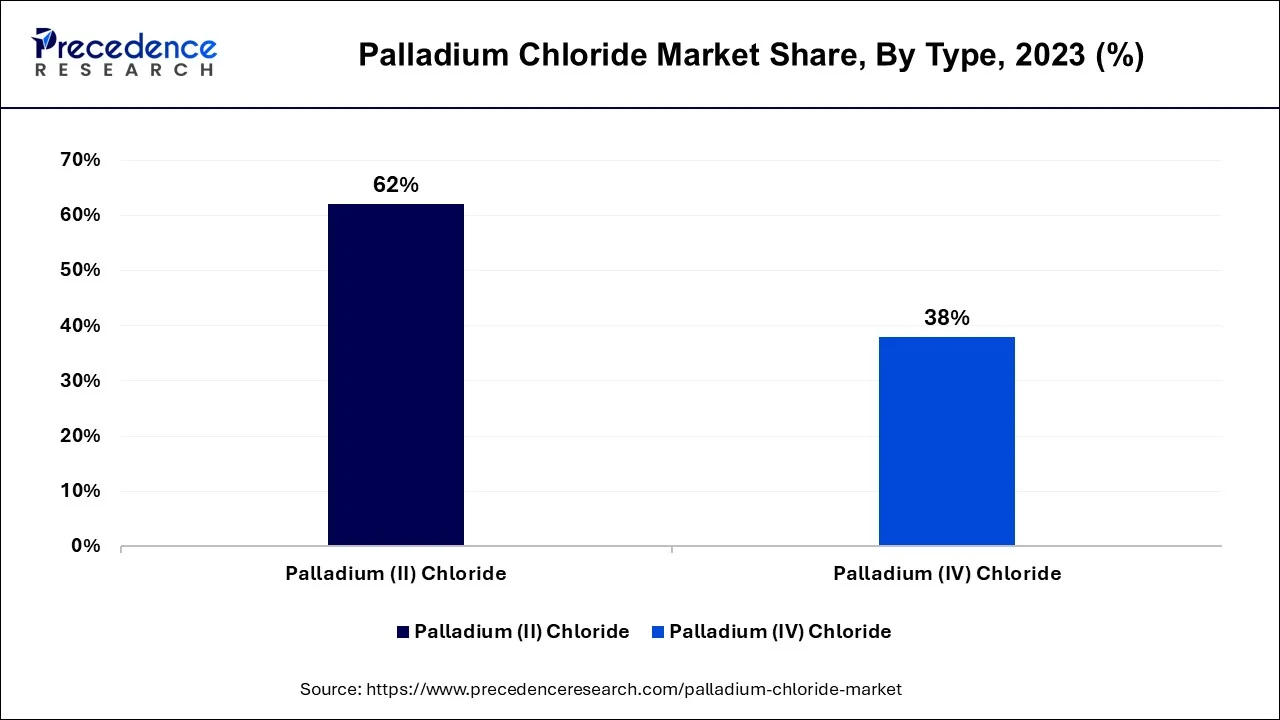List of Contents
Palladium Chloride Market Size and Forecast 2024 to 2034
The global palladium chloride market size accounted for USD 9.36 billion in 2024 and is anticipated to reach around USD 18.59 billion by 2034, rising at a CAGR of 7.10% between 2024 and 2034.

Palladium Chloride Market Key Takeaways
- North America contributed more than 38% of revenue share in 2023.
- Asia Pacific is estimated to expand the fastest CAGR between 2024 and 2034.
- By Type, the palladium (II) chloride segment has held the largest market share of 62% in 2023.
- By Type, the palladium (IV) chloride segment is anticipated to grow at a remarkable CAGR of 10.8% between 2024 and 2034.
- By Application, the catalysis segment generated over 39% of revenue share in 2023.
- By Application, the chemical synthesis segment is expected to expand at the fastest CAGR over the projected period.
- By End-user, the chemical industry segment had the largest market share of 42% in 2023.
- By End-user, the metallurgy segment is expected to expand at the fastest CAGR over the projected period.
U.S. Palladium Chloride Market Size and Growth 2024 to 2034
The U.S. palladium chloride market size ie estimated at USD 2.49 billion in 2024 and is expected to be worth around USD 5.01 billion by 2034, growing at a CAGR of 7.24% between 2024 and 2034.

North America has held the largest revenue share 38% in 2023. North America's palladium chloride market is characterized by a strong focus on research and innovation, with the United States being a key player in catalysis and electronics. Stringent environmental regulations are driving the adoption of greener chemistry practices, thereby influencing the use of palladium chloride. Additionally, the automotive industry's demand for palladium in catalytic converters remains robust. North America's market is poised for steady growth as it aligns with sustainability trends and ongoing research.

Asia Pacific is estimated to observe the fastest expansion. The region is witnessing robust growth in the palladium chloride market. Rapid industrialization and the electronics manufacturing sector's expansion have heightened the demand for palladium chloride, particularly in China, South Korea, and Japan. The shift towards cleaner energy sources, including fuel cells, also presents significant opportunities. Moreover, emerging markets like India offer untapped potential. Asia Pacific's market is dynamic, with increasing applications and expanding consumer bases, making it a prominent player in the global market.
A strong focus on sustainability and green chemistry practices marks the palladium chloride market in Europe. The region emphasizes strict environmental regulations, driving the adoption of eco-friendly palladium chloride applications. Additionally, the automotive sector's demand for palladium in catalytic converters aligns with the growing emphasis on reducing emissions. Europe's market combines traditional applications with emerging green technologies, positioning it as a vital contributor to the global palladium chloride industry.
Market Overview
The palladium chloride market pertains to the trade and distribution of palladium chloride, a chemical compound with various applications. This market primarily involves two common forms palladium (II) chloride and palladium (IV) chloride. Palladium chloride serves as a crucialcatalystin numerous chemical reactions and is widely used in chemical synthesis and electroplating processes.
It finds applications in the chemical industry, electronics manufacturing, metallurgy, and laboratories. The market caters to the demand from these sectors, providing them with this essential chemical for their diverse applications, and contributing to advancements in chemistry, electronics, and materials science.
Palladium Chloride Market Growth Factors
- The increasing demand for catalysts in chemical processes propels the market, especially in the production of fine chemicals and pharmaceuticals.
- Metallurgical applications: Metallurgical uses, particularly in alloy production, contribute to market expansion.
- The market is witnessing a trend towards sustainable and environmentally friendly chemical processes, influencing the choice of catalysts, including palladium chloride.
- Research and development: Ongoing R&D efforts aim to discover new applications and enhance the efficiency of palladium chloride in catalytic processes.
- The growing focus on recycling and reusing palladium resources contributes to sustainability in the industry.
- Challenges related to the availability and cost of palladium as a raw material can affect market stability.
- Exploring new applications in fields like green energy and fuel cell technology presents growth opportunities.
- Offering tailored palladium chloride solutions to meet the specific needs of different industries and applications can be a lucrative opportunity.
- Collaborating with research institutions and industry players to develop novel applications and improve product quality can foster market growth and innovation.
Market Scope
| Report Coverage | Details |
| Growth Rate from 2024 to 2034 | CAGR of 7.1% |
| Market Size in 2024 | USD 9.36 Billion |
| Market Size by 2034 | USD 18.59 Billion |
| Largest Market | North America |
| Base Year | 2023 |
| Forecast Period | 2024 to 2034 |
| Segments Covered | Type, Application, End User, and Region |
| Regions Covered | North America, Europe, Asia-Pacific, Latin America, and Middle East & Africa |
Market Dynamics
Driver
Metallurgical applications and electronics industry growth
Metallurgical applications and the thriving electronics industry are instrumental in surging the demand for the palladium chloride market. In metallurgy, palladium chloride is a crucial component for various alloy formulations, enhancing the mechanical and corrosion-resistant properties of metals. The increasing industrial applications, from aerospace to automotive sectors, have fueled the demand for advanced alloys, consequently boosting the need for palladium chloride.
Furthermore, the burgeoning electronics industry is a pivotal driver of demand. With ongoing consumer electronics and technology advancements, the need for top-quality electronic components and materials has seen a notable rise. Palladium chloride is utilized for electroplating processes in the electronics sector, providing the essential properties for manufacturing circuit boards, connectors, and semiconductors.
The relentless pace of innovation and the quest for miniaturization and enhanced performance in electronics drive the continuous demand for palladium chloride, making it a fundamental element in this industry. As these sectors expand, the palladium chloride market experiences robust growth, positioning itself as a critical player in various industrial applications.
Restraint
Environmental regulations, palladium availability and cost
Environmental regulations, limited palladium availability, and cost constraints pose significant challenges to the palladium chloride market, potentially restraining its demand. Stringent environmental regulations require careful handling and disposal of palladium chloride waste, increasing the operational and compliance costs for manufacturers. These regulations may necessitate investments in advanced waste management and treatment processes, which can strain profit margins.
The limited availability of palladium, a precious metal, can lead to price volatility, affecting the overall cost structure of palladium chloride production. Scarcity and price fluctuations can lead to unpredictable production costs, potentially making palladium chloride less economically viable for certain applications. Moreover, increased demand for palladium in other industries, such as automotive catalytic converters, can create supply challenges for palladium chloride manufacturers. These constraints on availability and cost may discourage potential users from adopting palladium chloride in their processes, hampering market demand.
Opportunity
Expansion into developing markets and exploring new applications
Expansion into developing markets and exploring new applications are key drivers that significantly surge the demand for the palladium chloride market. As developing economies experience rapid industrialization and technological growth, the need for palladium chloride escalates. These markets offer untapped opportunities for the chemical and electronics industries, both major consumers of palladium chloride. Expansion into these regions provides fresh consumer bases and can lead to increased sales and market exposure.
Furthermore, the exploration of new applications opens doors for innovative uses of palladium chloride. This involves diversifying its role beyond traditional applications, such as catalysis and electroplating, into emerging sectors like green energy and fuel cell technology. As the world shifts towards cleaner and more sustainable practices, palladium chloride's use in green technologies becomes particularly promising. This shift drives research and development, resulting in novel applications and increasing demand. Consequently, expansion into developing markets and embracing new applications not only bolsters the palladium chloride market but also positions it for long-term growth and adaptability in a rapidly changing industrial landscape.
Impact of COVID-19
The COVID-19 pandemic left a significant impact on the palladium chloride market. Initially, the market experienced disruptions in the supply chain and production processes due to lockdowns and restrictions. This caused volatility in palladium prices, affecting the cost of palladium chloride production. Moreover, reduced industrial activities in the early days of the pandemic led to a temporary decline in demand, particularly in the automotive sector, which utilizes palladium in catalytic converters.
As the world adapted to the new normal, the market witnessed a resurgence. The growing demand for electronics, especially for remote work and communication, stimulated the need for palladium chloride in electroplating.
The emphasis on green chemistry and the expansion of clean energy technologies boosted palladium chloride's application in fuel cells, providing a new avenue for market growth. Overall, the market demonstrated resilience and adaptability in the face of pandemic challenges, ultimately rebounding with renewed opportunities.
Type Insights
According to the type, the palladium (II) chloride segment has held a 62% revenue share in 2023. Palladium (II) chloride is a common form of palladium chloride, featuring palladium in a +2 oxidation state. It is a versatile catalyst widely used in chemical synthesis, catalytic processes, and electroplating. A key trend in the palladium chloride market related to this form is its sustained demand in catalytic applications, particularly in pharmaceutical and fine chemical production, driving the market's growth.

The palladium (IV) chloride segment is anticipated to expand at a significant CAGR of 10.8% during the projected period. Palladium (IV) chloride is another variant that involves palladium in a +4 oxidation state. It has more specialized uses in certain chemical reactions. In the market, a trend is emerging towards exploring its potential in niche applications, driven by ongoing research and development efforts to harness its unique properties for specific chemical processes.
Application Insights
Based on the application, catalysis segment is anticipated to hold the largest market share of 39% in 2023. Catalysis involves palladium chloride's use as a catalyst to facilitate chemical reactions. A notable trend is the increasing adoption of palladium chloride in pharmaceutical and fine chemical manufacturing. Its efficiency in promoting selective reactions has gained prominence, contributing to the growth of the market. Green chemistry practices have driven research into sustainable catalytic processes using palladium chloride, aligning with the global shift toward environmentally friendly chemical production.
On the other hand, the chemical synthesis segment is projected to grow at the fastest rate over the projected period. In chemical synthesis, palladium chloride plays a pivotal role in forming various compounds. A key trend is its application in the synthesis of complex organic molecules, including pharmaceutical intermediates. The market is witnessing a surge in demand for palladium chloride for these purposes, driven by advances in synthetic chemistry and the quest for more efficient and precise chemical reactions. This trend underscores the compound's versatility and continued relevance in chemical synthesis.
End-user Insights
In 2023, the chemical industry segment had the highest market share of 42% on the basis of the end user. In the palladium chloride Market, the chemical industry is a prominent end-user. Palladium chloride acts as a catalyst in various chemical reactions, notably in the production of fine chemicals and pharmaceuticals. A key trend in this sector is the increasing adoption of palladium chloride for sustainable and green chemistry practices, aligning with environmental regulations and consumer demands for eco-friendly products.
The metallurgy segment is anticipated to expand at the fastest rate over the projected period. Metallurgy is another significant end-user, utilizing palladium chloride, especially in alloy production. A trend in this sector is the development of advanced metallurgical processes that require palladium chloride to enhance the properties of alloys, making them suitable for specific applications. This highlights the vital role palladium chloride plays in shaping metallurgical advancements.
Palladium Chloride Market Companies
- Johnson Matthey Plc
- Heraeus Holding
- Umicore
- Anglo American Platinum
- BASF SE
- American Elements
- Metalor
- Sigma-Aldrich Corporation
- Tanaka Holdings Co., Ltd.
- Johnson Matthey
- Alfa Aesar
- Johnson Matthey Chemicals
- Vineeth Precious Catalysts Pvt. Ltd.
- Gelest, Inc.
- Goodfellow Cambridge Limited
Recent Developments
- In 2022, BASF and Heraeus collaborated to establish a joint venture in China, focusing on advanced precious metal recycling for high-tech industries. This initiative promotes a circular economy by recycling spent catalysts containing precious metals, contributing to sustainable resource management.
- In 2022, TANAKA Kikinzoku Kogyo contributed to the "DMC No. 1 Investment Limited Partnership" venture capital fund to support the establishment of a medical venture ecosystem in Japan. This investment aligns with the goal of advancing technology within Japan's medical and healthcare sector.
Segments Covered in the Report
By Type
- Palladium (II) Chloride
- Palladium (IV) Chloride
By Application
- Catalysis
- Chemical Synthesis
- Electroplating
- Laboratory Research
- Others
By End User
- Chemical Industry
- Electronics Industry
- Metallurgy
- Laboratories
- Others
By Geography
- North America
- Europe
- Asia-Pacific
- Latin America
- Middle East and Africa
For inquiries regarding discounts, bulk purchases, or customization requests, please contact us at sales@precedenceresearch.com
Frequently Asked Questions
Ask For Sample
No cookie-cutter, only authentic analysis – take the 1st step to become a Precedence Research client